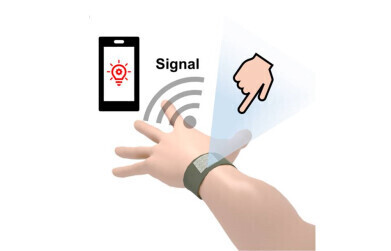-
 3D finger recognition and data transmission to a mobile phone.
3D finger recognition and data transmission to a mobile phone.
Research News
Revolutionary touch sensor redefines robotics sensing technology
Mar 08 2024
In a significant leap for robotics and bio-mimicking applications, researchers at Qingdao University, China, have introduced a cutting-edge touch sensor that operates without direct contact with objects. This innovative sensor detects interference in the electric field at a remarkable distance of up to 100 millimetres from the object, providing unprecedented sensitivity. According to Xinlin Li of the Qingdao University team: "To bring greater sensitivity and versatility, we have developed new composite films with surprising and very useful electrical properties." The researchers at Qingdao University in China, with collaborators elsewhere in China and South Korea, describe their innovation in the journal Science and Technology of Advanced Materials [1].
The researchers combined materials with a high dielectric constant, yielding a composite with an unexpectedly low dielectric constant. This counter-intuitive result enhances the sensor's sensitivity to electric fields, enabling it to outperform traditional touch sensors. The composite, consisting of graphitic carbon nitride and polydimethylsiloxane, undergoes a specific 3D printing method called dispensing printing, allowing precise control over structure and pattern.
In experiments, the sensor demonstrated outstanding performance in terms of sensitivity, response speed, and robust stability through numerous cycles of use. The team tested the sensor by using their fingers as objects detected between 5 and 100 millimetres away, without actual contact. Li emphasised: "This opens new possibilities in the field of wearable objects and electronic skin."
The sensing grid, incorporated into a printed circuit board, enables data transmission over 4G networks, commonly used by mobile phones. The technology's potential applications extend to medical monitoring, wearable technologies, and human-computer interaction, such as gesture recognition. The researchers plan to refine the technology for mass production and explore additional applications beyond shape and movement detection.
More information online
Digital Edition
Lab Asia 31.6 Dec 2024
December 2024
Chromatography Articles - Sustainable chromatography: Embracing software for greener methods Mass Spectrometry & Spectroscopy Articles - Solving industry challenges for phosphorus containi...
View all digital editions
Events
Nov 27 2024 Istanbul, Turkey
Jan 22 2025 Tokyo, Japan
Jan 22 2025 Birmingham, UK
Jan 25 2025 San Diego, CA, USA
Jan 27 2025 Dubai, UAE
.jpg)

















